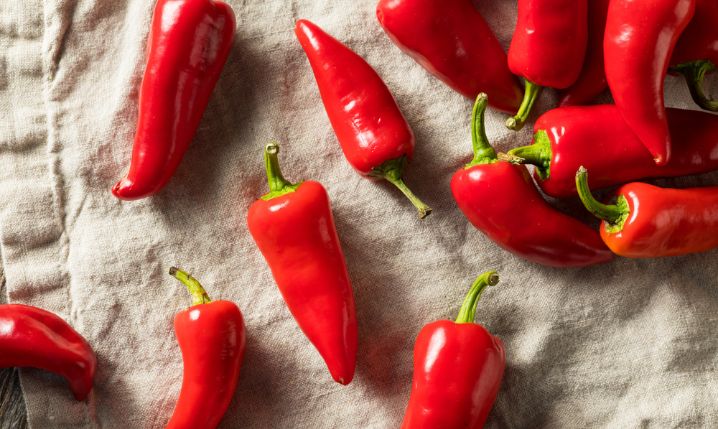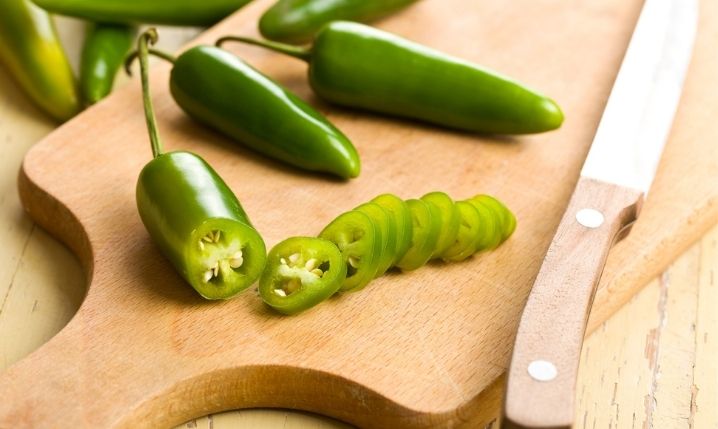With so many chili peppers out there, it’s common to see one recommended for the other. Often two types might look the same. It all makes you wonder what the differences are. In this article, we’ll explore the Fresno pepper vs. jalapeño so that you can find out all you need to know!
Contents:
What Are Fresno Peppers?

Fresno Peppers originated in the State of New Mexico, US in 1952. They were first cultivated by Clarence Brown Hamlin, who named them after Fresno, California.
Most often sold when mature, Fresno peppers are best known for a red visual appearance. When matured they have a famous fruitiness and smokiness that makes them much-loved by cooks and chefs around the world.
Though it’s not as easy to find the less mature Fresno pepper, it can be worth doing as they have a grassier bite that tastes more similar to a jalapeño.
They are considered to be a milder pepper as they have a Scoville heat unit rating between 2,500-10,000 SHU.
Fresno chili peppers are moderately small peppers, around 2 inches long with thick, but not particularly waxy walls.
You can use Fresno peppers for pickling, stuffing, salsas, hot sauces, ceviche, rice and bean dishes, and various Mexican and Tex-Mex dishes.
What Are Jalapeños?

Jalapeño peppers are Mexican chilies that are known worldwide as one of the most popular chili peppers. They are considered mild to moderate as they have a heat unit range between 2,500 to 8,000 SHU.
Today, the jalapeño is cultivated in Mexico and the United States, especially in the southwest where it is widely grown in Texas and New Mexico. As one of the most popular peppers in the world, it has even found its way into Asian cuisine, such as Thai.
They are most often sold when not fully mature, so you might be most used to seeing them a rich green. When jalapeños mature they go red. While immature they have a bright grassy bite that makes them a versatile culinary pepper that can be used for everything from salads to pickling. As they mature the flavor becomes much sweeter.
The jalapeño is around 2.5 to 3 inches long with a conical shape similar to the Fresno pepper.
You can use jalapeños for pickling, salsa, hot sauces, sofritos, jalapeno poppers, roasting, and more.
What’s The Difference Between Fresno Peppers and Jalapeños?
| Fresno Pepper | Jalapeño Pepper |
|---|---|
| 2,500 – 10,000 Scoville heat units (SHU) | 2,500 – 8,000 Scoville heat units (SHU) |
| Bright, Grassy, Fruity, Smoky | Bright, Grassy, Bitter |
| 2 inches long with thick cavity walls | 2.5 – 3 inches long. |
| Originally from the United States | Originally from Mexico |
With both peppers being considered mild-moderate on the heat scale, both having a bright and grassy taste when immature, similar overall sizes and shapes, and both being widely grown in New Mexico, it’s easy to see why these peppers often get mixed up in the grocery store.
They make excellent substitutes for one another, working in most of the same dishes as one another. Jalapeños are perhaps more versatile than Fresno peppers, but they both have distinctive tastes that some cook’s covet them for in some dishes more than others.
One big difference between the two is that Fresno peppers are most sold when mature while jalapeños aren’t often sold when matured. This can increase the differences in taste between the two as their flavors only really align well when both peppers are immature.
- Size: Both the Fresno pepper and jalapeño pepper range between 2-3 inches long with up to inch thick diameters.
- Appearance: You will most often find Fresno peppers looking conical and red, while jalapeños most often appear on the shelves green, and also conical shaped.
- Taste and texture: Fresno peppers have fruity smoky flavors when mature, while the jalapeño has a bright, grassy, juiciness. They both have a bit of crunch as these chilies have medium-thick skins.
- Culinary uses: You can roast, pickle, slice, blend, and do anything you can think of with these chili peppers. They also make excellent substitutes for one another in salsas, fajitas, and more.
Conclusion
Both the Fresno pepper and the jalapeño pepper have similar Scoville heat unit ranges, similar flavors when non-mature, similar textures, and work well for one another in substitute situations. When it comes to the Fresno pepper vs. jalapeño you now know the important differences so that you can use them interchangeably as and when required.